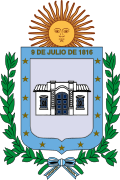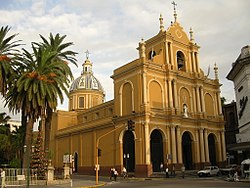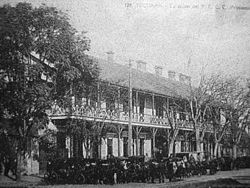San Miguel de Tucumán
San Miguel de Tucumán (usually called simply Tucumán) is the capital of the Tucumán Province; it is in northern Argentina 1,311 kilometres (815 mi) from Buenos Aires. The Spanish Conquistador Diego de Villarroel founded the city in 1565 during an expedition from present-day Peru. The city was moved to its present site in 1685.
|
Tucumán | |
|---|---|
| Coordinates: 26°49′59″S 65°13′00″W / 26.83306°S 65.21667°WCoordinates: 26°49′59″S 65°13′00″W / 26.83306°S 65.21667°W | |
| Country | Argentina |
| Province | Tucumán |
| Founded | 1565, 1685 |
| Government | |
| • Intendant | Germán Enrique Alfaro[1] |
| Area | |
| • Total | 90 km2 (30 sq mi) |
| Elevation | 431 m (1,414 ft) |
| Population (2010)[2] | |
| • Total | 548,866 |
| • Density | 6,100/km2 (15,800/sq mi) |
| Time zone | UTC-03 (ART) |
| Climate | Humid subtropical climate (Cwa) |
| Website | Official website |
History
The city, with the name of San Miguel de Tucumán y Nueva Tierra de Promisión, was founded on 31 May 1565 by Diego de Villarroel in the place called Campos de Ibatín, about 60 kilometres (37 mi) to the southwest of the present city. Then, in 1685, the town was moved to where it is now because of the low quality of the water.
On 24 September 1812, the Battle of Tucumán took place near the city, when the Spanish army was defeated by the army led by Manuel Belgrano. The act of the Independence was signed at the Casa de Tucumán ("Tucumán House").
Geography
The city is surrounded by the departments
- Tafí Viejo to the north;
- Cruz Alta to the east;
- Lules to the south; and
- Yerba Buena to the west.
The city is on the slopes of the Aconquija mountains along the Salí river. The altitude in the centre of the city is 450 m (1,480 ft). It is the commercial centre of an irrigated area that produces sugarcane, rice, tobacco, and fruits.
San Miguel de Tucumán has an area of 90 km2 (35 sq mi) and a population of 548,866, in 2010, for a population density of 6,099 inhabitants/km2.
Climate
San Miguel de Tucumán has a humid subtropical climate (subtype Cfa in the Köppen climate classification).
The average temperature for the year in San Miguel de Tucumán is 19.3 °C (66.7 °F). The warmest month, on average, is January with an average temperature of 25.3 °C (77.5 °F). The coolest month on average is July, with an average temperature of 12.1 °C (53.8 °F).
The average amount of precipitation for the year in San Miguel de Tucumán is 1,013.5 mm (39.9 in). The month with the most precipitation on average is January with 210.8 mm (8.3 in) of precipitation. The month with the least precipitation on average is July with an average of 10.2 mm (0.4 in).[3]
| Climate data for Tucumán, Argentina | |||||||||||||
|---|---|---|---|---|---|---|---|---|---|---|---|---|---|
| Month | Jan | Feb | Mar | Apr | May | Jun | Jul | Aug | Sep | Oct | Nov | Dec | Year |
| Average high °C (°F) | 31.3 (88.3) |
30.2 (86.4) |
27.7 (81.9) |
24.4 (75.9) |
21.2 (70.2) |
18.2 (64.8) |
19.1 (66.4) |
22.5 (72.5) |
24.5 (76.1) |
29.0 (84.2) |
29.6 (85.3) |
30.6 (87.1) |
25.69 (78.25) |
| Daily mean °C (°F) | 25.3 (77.5) |
24.2 (75.6) |
22.2 (72) |
19.1 (66.4) |
15.5 (59.9) |
12.2 (54) |
12.1 (53.8) |
14.7 (58.5) |
17.1 (62.8) |
21.6 (70.9) |
23.2 (73.8) |
24.9 (76.8) |
19.34 (66.82) |
| Average low °C (°F) | 20.2 (68.4) |
19.2 (66.6) |
18.0 (64.4) |
15.1 (59.2) |
11.0 (51.8) |
7.6 (45.7) |
6.8 (44.2) |
8.6 (47.5) |
10.6 (51.1) |
15.1 (59.2) |
17.5 (63.5) |
19.4 (66.9) |
14.09 (57.37) |
| Rainfall mm (inches) | 210 (8.27) |
180 (7.09) |
160 (6.3) |
60 (2.36) |
20 (0.79) |
10 (0.39) |
10 (0.39) |
10 (0.39) |
10 (0.39) |
60 (2.36) |
100 (3.94) |
160 (6.3) |
990 (38.98) |
| Source: Weatherbase | |||||||||||||
Places of interest
Some interesting places in San Miguel de Tucumán are:
- Plaza Independencia ("Independence square")
- Casa de Gobierno de Tucumán ("Tucumán Government Palace")
- Catedral de San Miguel de Tucumán ("San Miguel de Tucumán cathedral")
- Basilica of San Francisco ("Saint Francis Basilica")
- Casa de Tucumán ("Tucumán House" or "Independence House")
Twin towns
San Miguel de Tucumán is twinned with:[4]
 Nazareth Illit, Israel, since 1995
Nazareth Illit, Israel, since 1995 Santa Cruz de la Sierra, Bolivia, since 1997
Santa Cruz de la Sierra, Bolivia, since 1997 Sucre, Bolivia, since 2012
Sucre, Bolivia, since 2012 Erfurt, Thuringia, Germany, since 2012
Erfurt, Thuringia, Germany, since 2012 Concepción, Chile, since 2013
Concepción, Chile, since 2013
Gallery
San Miguel De Tucumán Media
"Tucumán 1812", by Gerardo Flores Ivaldi. The Cabildo and San Francisco church are displayed on the painting.
Former Tucumán station built by North Western Railway, c. 1890.
Casa de Tucumán, where Argentine Independence was declared.
References
- ↑ "Intendencia". Municipalidad de San Miguel de Tucumán. Archived from the original on 20 May 2017. Retrieved 29 May 2017.
- ↑ "Argentina: Tucumán". City Population. Retrieved 29 May 2017.
- ↑ "Tucuman, Argentina - Köppen Climate Classification". Weatherbase. Retrieved 29 May 2017.
- ↑ "Hermanamiento de Ciudades". Municipalidad de San Miguel de Tucumán. Archived from the original on 6 June 2017. Retrieved 29 May 2017.
Other websites
| Wikimedia Commons has media related to Lua error in Module:Commons_link at line 62: attempt to index field 'wikibase' (a nil value).. |
- San Miguel de Tucumán official website (in Spanish)
- Ente Tucumán Turismo official website Archived 2017-06-06 at the Wayback Machine
- Universidad Nacional de Tucumán Archived 2021-11-04 at the Wayback Machine Tucuman State University (in Spanish)
- Universidad del Norte Santo Tomas Aquino Archived 2020-12-07 at the Wayback Machine Tucuman Catholic University (in Spanish)
- Universidad Tecnologica Nacional (Tucuman Campus) Archived 2011-05-31 at the Wayback Machine (in Spanish)














